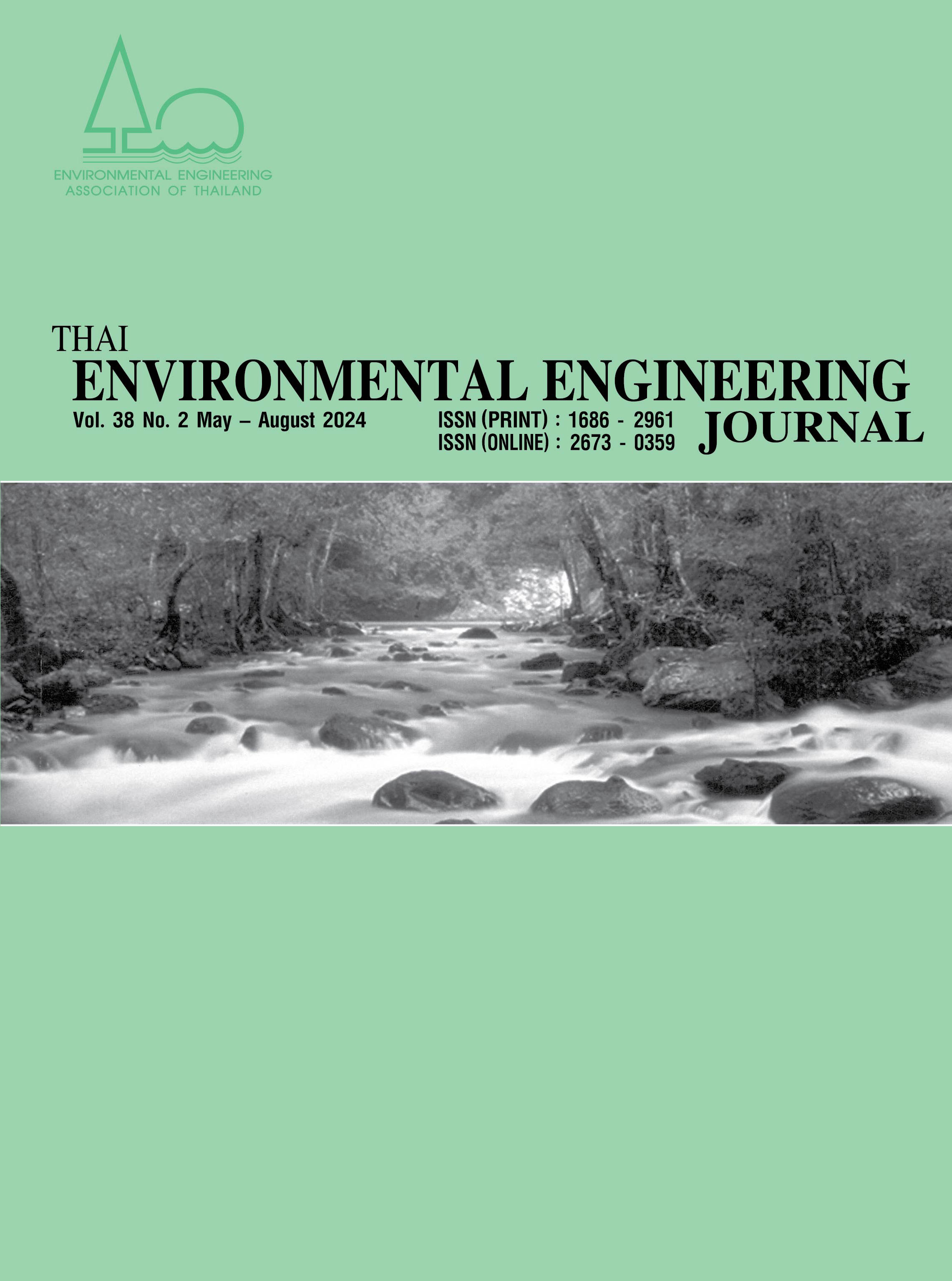Assessment of Airborne Microbial Contamination in Cosmetics Manufacturing Facilities: Skincare Cream Production in Thailand
Main Article Content
Abstract
Skincare is a variety of practices to maintain skin integrity, enhance appearance, and alleviating skin conditions. Thailand's skincare market has seen substantial growth, becoming the dominant sub-sector in cosmetics. Microbial contamination in the skincare can occur when the manufacturing process are not well controlled. The objective of this research is to establish criteria for managing appropriate levels of microbial quantities in the air of Good Manufacturing Practice (GMP) cosmetics production facilities. Airborne microbial samples are collected using both active air sampler and settle plate techniques at varying time intervals, followed by a comparative analysis. The skincare creams as representatives showed that the total airborne microbial counts using the air sampling method, ranged from 85 to 252 cfu/m3. For the settle plate method for 4 and 1 hours ranged from 8 to 90 cfu/4h and 1 to 59 cfu/h. The action limits from control charts at 341 cfu/m3, 107 cfu/4h, and 59 cfu/h for the respective methods. Based on the results of this research, it can be concluded that the monitoring criteria for cosmetics manufacturing facilities, with a specified limit for airborne microbial counts not exceeding 100 cfu/4h (sterile medicinal products at Grade D) or 50 cfu/h (moderate IMA level).
Article Details
References
The United States Pharmacopeial Convention. 2018. The United States Pharmacopeia and the National Formulary (USP 41-NF36). Rockville, MD.
Sutton, S. and Jimenez, L. 2012. A Review of Reported Recalls Involving Microbiological Control 2004-2011 with Emphasis on FDA Considerations of “Objectionable Organisms”. American Pharmaceutical Review. http://www.americanpharmaceuticalreview.com/Featured-Articles/38382-A-Review-of-Reported-Recalls-Involving-Microbiological-Control-2004-2011-with-Emphasis-on-FDA-Considerations-of-Objectionable-Organisms/
Franki, R. 2018. Bacterial contamination behind most cosmetics recalls. Dermatology News. https://www.mdedge.com/dermatology/article/191072/health-policy/bacterial-contamination-behind-most-cosmetics-recalls
ISO 17516. 2014. Cosmetics - Microbiology - Microbiological limits. The International Organization for Standardization, Geneva.
Regulation (EC). 2009. No 1223/2009 of the European Parliament and of the Council of 30 November 2009 on cosmetic products.
ISO 29621. 2017. Cosmetics - Microbiology - Guidelines for the risk assessment and identification of microbiologically low-risk products. The International Organization for Standardization, Geneva.
Sandle, T. 2019. Biocontamination Control for Pharmaceuticals and Healthcare. Academic Press, London.
European Commission. 2008. Good Manufacturing Practice (EU GMP) guidelines. European Commission.
World Health Organization. 2011. WHO Technical Report Series, No. 961, Annex 6. WHO Good Manufacturing Practices for sterile pharmaceutical products. http://www.who.int/medicines/areas/quality_safety/quality_assurance/GMPSterilePharmaceuticalProductsTRS961 Annex6.pdf
World Health Organization. 2012. Environmental Monitoring of Clean Rooms in Vaccine Manufacturing Facilities, E.M.a.H.P. (EMP), Editor. World Health Organization, Geneva.
Parenteral Drug Association (PDA). 2001. Fundamentals of an Environmental Monitoring Program. Technical Report No. 13 Revised - Supplement TR13. 55(5).
Pasquarella, C., Pitzurra, O. and Savino, A. 2000. The index of microbial air contamination. Journal of Hospital Infection. 46(4): 241-256.
Salaman-Byron, A.L. 2018. Limitations of Microbial Environment Monitoring Methods in Cleanrooms. American Pharmaceutical Review. https://www.americanpharmaceuticalreview.com/Featured-Articles/349192-Limitations-of-Microbial-Environmental-Monitoring-Methods-in-Cleanrooms/
Pitzurra, M., Savino, A., and Pasquarella, C. 1997. LINEE GUIDA Il monitoraggio microbiologico negli ambienti di lavoro Campionamento e analisi Il Monitoraggio ambientale microbiologico (MAM). Annali di Igiene, 9: 439-454. https://www.inail.it/cs/internet/docs/alg-il-monitoraggio-microbiologico-negli-ambienti-lavoropdf.pdf
ASEAN Cosmetic Committee. 2003. ASEAN Guidelines for Cosmetic Good Manufacturing Practices. http://www.fda.moph.go.th/sites/Cosmetic/SitePages/ViewGMP.aspx?IDitem=4
ISO 16000-18. 2011. Indoor air Part 18: Detection and enumeration of moulds - Sampling by impaction. The International Organization for Standardization, Geneva.
ISO 11133. 2014. Microbiology of food, animal seed and water - Preparation, production, storage and performance testing of culture media. The International Organization for Standardization, Geneva.
American Public Health Association (APHA). 1999. Standard Methods for the Examination of Water and Wastewater. American Water Works Association, Water Environment Federation, Washington DC. #9215
Lane, D. J. 1991. 16S/23S rRNA sequencing. In: E. Stackebrandt & M. Goodfellow (Eds.), Nucleic Acid Techniques in Bacterial Systematics. John Wiley and Sons, New York. 115-175.
Yoon, S.H., Ha, S.M., Kwon, S. and add et. al. 2017. Introducing EzBioCloud: a taxonomically united database of 16S rRNA gene sequences and whole-genome assemblies. International Journal of Systematic and Evolutionary Microbiology. 67(5): 1613-1617.
ISO 8258. 1991. Shewhart control charts. The International Organization for Standardization, Geneva.
ISO 7218. 2007. Microbiology of food and animal feeding stuffs – General requirements and guidance for microbiological examinations. The International Organization for Standardization, Geneva.
Sandle, T. 2020. Microbiological environmental monitoring - a review of current standards. [Webinar]. https://www.youtube.com/watch?app=desktop&v=nTpWcwjfmfE
Anaya, M., Gámez-Espinosa, E., Falco, A.S., Benítez, E., and Carballo, G. 2019. Characterization of indoor air mycobiota of two locals in a food industry, Cuba. Air Quality, Atmosphere & Health. 12: 797-805.
Scholtz, I., Siyoum, N. and Korsten, L. 2017. Penicillium air mycoflora in postharvest fruit handling environments associated with the pear export chain. Postharvest Biology and Technology. 128: 153-160.
Sandle, T. 2011. A Review of Cleanroom Microflora: Types, Trends, and Patterns. PDA Journal of Pharmaceutical Science and Technology. 65(4): 392-403. https://journal.pda.org/content/65/4/392
Dao, H., Lakhani, P., Police, A., and add et. al. 2017. Microbial Stability of Pharmaceutical and Cosmetic Products. AAPS PharmSciTech. 19(1): 60-77. https://doi.org/10.1208/s12249-017-0875-1
Clontz, L. 2008. Microbial limit and bioburden tests: validation approaches and global requirements (2nd ed.). https://pharmprobeg.ru/download/Suzdal_2021-05/Lucia_Clontz_Microbial_Limit_and_Bioburden_TestsBookFi.org1_.pdf


